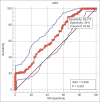Atherogenic index of plasma: A valuable novel index to distinguish patients with unstable atherogenic plaques
- PMID: 35968214
- PMCID: PMC9374144
- DOI: 10.4103/jrms.jrms_590_21
Atherogenic index of plasma: A valuable novel index to distinguish patients with unstable atherogenic plaques
Abstract
Background: Plaque instability is a leading cause of morbidity and mortality in coronary artery disease (CAD) patients. Numerous efforts have been made to figure out and manage unstable plaques prior to major cardiovascular events incidence. The current study aims to assess the values of the atherogenic index of plasma (AIP) to detect unstable plaques.
Materials and methods: The current case-control study was conducted on 435 patients who underwent percutaneous coronary intervention due to chronic stable angina (stable plaques, n = 145) or acute coronary syndrome (unstable plaques, n = 290). The demographic, comorbidities, chronic medications, biochemical and hematological characteristics of the patients were entered into the study checklist. The baseline AIP was measured according to the formula of triglycerides/high-density lipoprotein logarithm. Binary logistic regression was applied to investigate the standalone association of AIP with plaque instability. Receiver operating curve (ROC) was depicted to determine a cut-off, specificity, and sensitivity of AIP in unstable plaques diagnosis.
Results: AIP was an independent predictor for atherogenic plaque unstability in both crude (odds ratio [OR]: 3.677, 95% confidence interval [CI]: 1.521-8.890; P = 0.004) and full-adjusted models (OR: 15, 95% CI: 2.77-81.157; P = 0.002). According to ROC curve, at cut-point level of 0.62, AIP had sensitivity and specificity of 89.70% and 34% to detect unstable plaques, respectively (area under the curve: 0.648, 95% CI: 0.601-0.692, P < 0.001).
Conclusion: According to this study, at the threshold of 0.62, AIP as an independent biomarker associated with plaque instability can be considered a screening tool for patients at increased risk for adverse events due to unstable atherosclerotic plaques.
Keywords: Acute coronary syndrome; atherogenic plaque; atherosclerosis; coronary artery disease; stable angina.
Copyright: © 2022 Journal of Research in Medical Sciences.
Conflict of interest statement
There are no conflicts of interest.
Figures
Similar articles
-
Predictive value of atherogenic index of plasma and atherogenic index of plasma combined with low-density lipoprotein cholesterol for the risk of acute myocardial infarction.Front Cardiovasc Med. 2023 May 26;10:1117362. doi: 10.3389/fcvm.2023.1117362. eCollection 2023. Front Cardiovasc Med. 2023. PMID: 37304956 Free PMC article.
-
Atherogenic Index of Plasma Predicts Obstructive Coronary Artery Disease in Patients with Stable Angina Pectoris.Diagnostics (Basel). 2023 Oct 19;13(20):3249. doi: 10.3390/diagnostics13203249. Diagnostics (Basel). 2023. PMID: 37892070 Free PMC article.
-
Gender-specific associations between atherogenic index of plasma and the presence and severity of acute coronary syndrome in very young adults: a hospital-based observational study.Lipids Health Dis. 2019 Apr 13;18(1):99. doi: 10.1186/s12944-019-1043-2. Lipids Health Dis. 2019. PMID: 30987629 Free PMC article.
-
Atherogenic Index of Plasma and Coronary Artery Disease in the Adult Population: A Meta-Analysis.Front Cardiovasc Med. 2021 Dec 16;8:817441. doi: 10.3389/fcvm.2021.817441. eCollection 2021. Front Cardiovasc Med. 2021. PMID: 34977202 Free PMC article.
-
Calcium deposition within coronary atherosclerotic lesion: Implications for plaque stability.Atherosclerosis. 2020 Aug;306:85-95. doi: 10.1016/j.atherosclerosis.2020.05.017. Epub 2020 Jun 14. Atherosclerosis. 2020. PMID: 32654790 Review.
Cited by
-
Assessment of eight insulin resistance surrogate indexes for predicting metabolic syndrome and hypertension in Thai law enforcement officers.PeerJ. 2023 May 29;11:e15463. doi: 10.7717/peerj.15463. eCollection 2023. PeerJ. 2023. PMID: 37273533 Free PMC article.
-
Pre-diabetes and cardiovascular risk factors in NAFLD patients: a retrospective comparative analysis.Front Endocrinol (Lausanne). 2025 Feb 7;16:1416407. doi: 10.3389/fendo.2025.1416407. eCollection 2025. Front Endocrinol (Lausanne). 2025. PMID: 39991738 Free PMC article.
-
The assessment of no-reflow phenomenon incidence in early versus delayed percutaneous coronary intervention following a primary fibrinolysis.ARYA Atheroscler. 2024 Mar-Apr;20(2):31-40. doi: 10.48305/arya.2024.42104.2921. ARYA Atheroscler. 2024. PMID: 39170814 Free PMC article.
-
Association of adverse childhood experiences with lipid profiles and atherogenic risk indices in a middle-to-older aged population.SSM Popul Health. 2023 Apr 5;22:101393. doi: 10.1016/j.ssmph.2023.101393. eCollection 2023 Jun. SSM Popul Health. 2023. PMID: 37090689 Free PMC article.
-
Dairy consumption and premature coronary artery disease onset: Iran premature coronary artery disease (IPAD) study insights.Sci Rep. 2025 Jan 2;15(1):408. doi: 10.1038/s41598-024-83072-5. Sci Rep. 2025. PMID: 39747392 Free PMC article.
References
-
- Organization WH. Global Status Report on Noncommunicable Diseases 2014. The United States: World Health Organization; 2014.
-
- Deaton C, Froelicher ES, Wu LH, Ho C, Shishani K, Jaarsma T. The global burden of cardiovascular disease. Eur J Cardiovasc Nurs. 2011;10 Suppl 2:S5–13. - PubMed
-
- Benjamin EJ, Muntner P, Alonso A, Bittencourt MS, Callaway CW, Carson AP, et al. Heart disease and stroke statistics – 2019 update: A report from the American Heart Association. Circulation. 2019;139:e56–528. - PubMed
-
- Fernández-Macías JC, Ochoa-Martínez AC, Varela-Silva JA, Pérez-Maldonado IN. Atherogenic index of plasma: Novel predictive biomarker for cardiovascular illnesses. Arch Med Res. 2019;50:285–94. - PubMed
LinkOut - more resources
Full Text Sources
Miscellaneous

